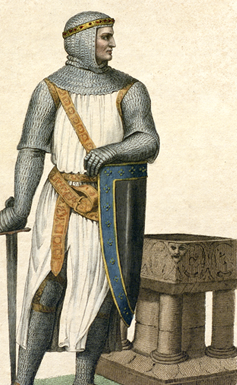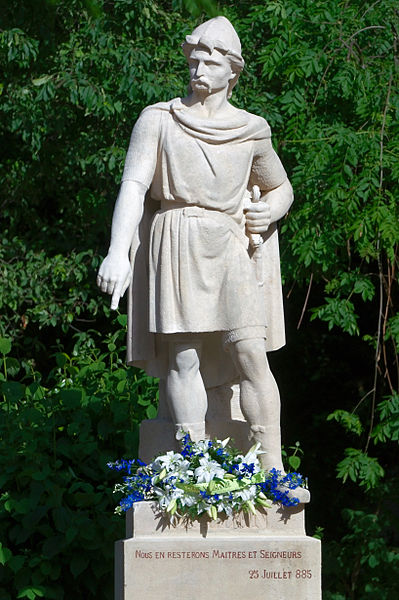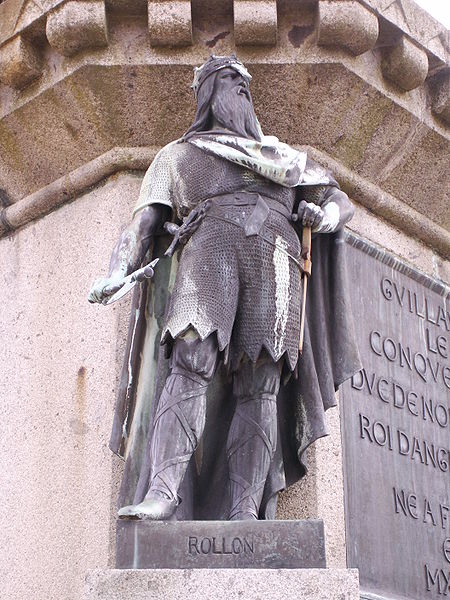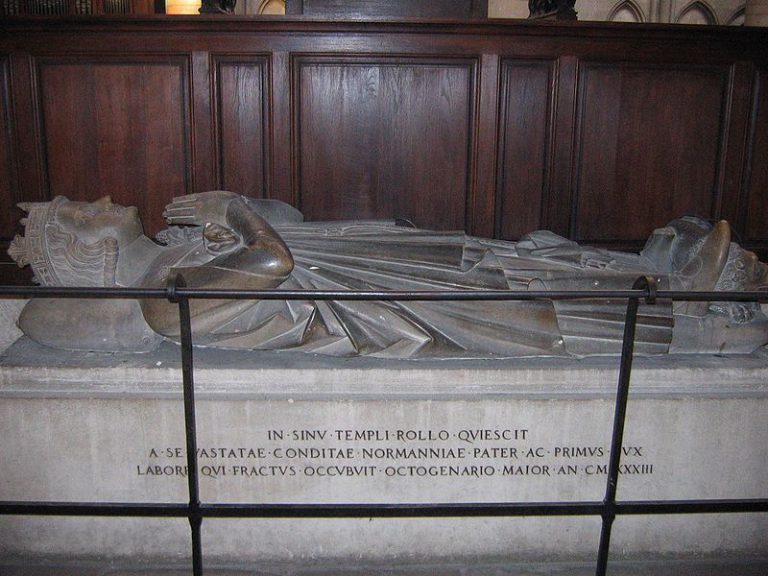Lithography of Rollo, first duke of Normandy
First Earl of Normandy, Rollo has generated much controversy. From Denmark or Norway, his story is known to us through Dudo of Saint -Quentin, Norman chronicler of 11th century.
Forced into exile due to looting, Rollo, also called Rou, or Robert I the Rich after his baptism, took the head of an army of Vikings.
“[…] The Danes and their Duke Rollo set their sails to the wind, and leaving the river Scheldt to navigate through the sea, in the year 876 of the Incarnation of the Lord, they entered the waters of the Seine, driven by a favorable wind, arrived at Jumiège […]. […] Franco, archbishop of Rouen, having learned their arrival, seeing the walls of the city overthrown by them, with a hostile ferocity, and not expecting any help that could resist them, thought it would be better to ask them peace as the cause for any to complete the ruin of the city approach. “( William of Jumieges , History of the Normans, from its origins to the year 1137, Rome, 2007 , second book , chapter IX , p.52 and 53. )
He participated in numerous raids and the siege of Paris in 885-886 and that of Bayeux from 886 to 890, then opposed to the Britons. He probably left Normandy to England, before he returned and signed a pact with the Archbishop of Rouen : “Now King Charles heard that Rollo was back from the English country, after having happily accomplished his expedition, sent Franco, archbishop of Rouen, asking him to refrain from doing harm to the Franks and grant him three-month truce .”( William of Jumieges , p. 60-61 ) .
However, in 911, once the truce last, he resumed the siege of Paris in vain and then attacked Chartres. He was defeated by the alliance of Robert, Marquis of Neustria of Ebles Manzer, count of Poitiers and Richard of Burgundy. Despite this victory on Rollo and his Norman troops, Charles the Simple wants to negotiate with them. Indeed, the status of Rollo is unique as the only legitimate leader for the Normans. For several decades, Rollo is known by different raids undertaken and meetings with Franco, Archbishop of Rouen. The episode of the siege of Chartres allowed him to assert , despite the defeat , before the princes. Negotiations led to the Treaty of Saint -Clair- sur- Epte, which gave Rollo the territory between the Seine and Brittany, genesis of the Duchy of Normandy, in exchange for protection and coastal defense against the onslaught vikings. He also agreed to be baptized, taking as given name Robert, referring to his godfather, Robert, Marquis of Neustria. He also married Gisla, daughter of Charles the Simple, who died without giving him an heir. And Rollo became the ‘jarl’ – Earl – of Normans, which is the equivalent of a prince and a count of Rouen. He governed his territory by enforcing laws and restoring peace. His excellent relationship with the archbishop of Rouen also enabled him to restore monastic life. The end of his reign also leaves room for speculation: did he die during the siege of Eu or did he abdicate in favor of his son ? Historical sources do not confirm neither of theses thesis. In 927, his son William, born of his first marriage, succeeded him , and took the name of William Longsword .
For further details :
Guillaume de Jumièges, Histoire des Normands, des origines jusqu’ à l’année 1137, éditions Paleo, Rome, 2007
Pierre Bauduin, La première Normandie (X-XIe siècles) : sur les frontières de la Haute-Normandie : identité et construction d’une principauté, Presse Universitaire de Caen, Caen, 2nde édition, 2006.
- Date details
19th Century
- Institution
Archives départementales de Seine – Maritime
- Original reference
74 Fi 6/6
- Period
Middle Ages
- Thematic
Politics and military links
Rouen – Archives Départementales





